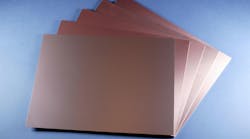Many developments are setting this IMS apart from previous years, such as the growing, widespread industry interest in millimeter-wave (mmWave) frequencies. Frequency bands at 60 and 77 GHz, once considered experimental, are now being thought of as mainstream, since they’re the basis for automotive radar systems and for high-speed, short-haul data links in 5G wireless networks.
Visitors to the 2018 IMS exhibition floor will find many companies proclaiming their devices, components, and even test equipment for mmWave applications. But circuits for these frequencies at about 28 GHz and above start with printed-circuit-board (PCB) materials. On that front, Rogers Corp., with its Advanced Connectivity Solutions (ACS) group at IMS booth 939, will be on hand to show circuit materials specially developed for such high frequencies.
For example, circuit materials in Rogers’ RO3000 product line include the RO3003 (see figure), RO3006, RO3010, and RO3035 circuit materials for circuit designers in need of dielectric constants (Dk) from 3.0 to 10.2. The RO3000 line of circuit materials is usable to 77 GHz and higher for advanced driver-assistance system (ADAS) applications such as automotive front and rear collision-avoidance radar systems and vehicle-to-vehicle (V2V) communications systems.
RO3003 circuit materials are ceramic-filled PTFE composites with low transmission-line loss well into the mmWave frequency range. (Courtesy of Rogers Corp.)
The materials maintain Dk values that are consistent across the circuit board as well as with changing temperatures. They also exhibit low coefficient of thermal expansion (CTE) so that structures formed in a PCB, such as a plated through hole (PTH), will maintain their form over a wide operating temperature range.
Of course, Rogers is not just a “one-trick pony” when it comes to PCB materials, and will have samples on display for lower-frequency applications as well as for rugged military/aerospace applications. RO4000 circuit materials maintain consistent Dk and CTE values for microwave-frequency circuits, but can be processed using the same low-cost fabrication methods as FR4 circuit materials. For those in the trenches, Rogers’ CLTE Series circuit materials are formulated for aerospace and defense applications. They have low Dk (below 3) and low water absorption. The ceramic/fiberglass/PTFE composite materials use a woven glass matrix to achieve high-level dimensional stability and reliability in a wide range of applications, including in avionics, EW, ELINT, SIGINT, and radar systems.
Visitors to the Rogers’ booth can learn which circuit materials are best suited for which of their applications, saving money while they give their circuit designs the best chance to exceed performance goals.

